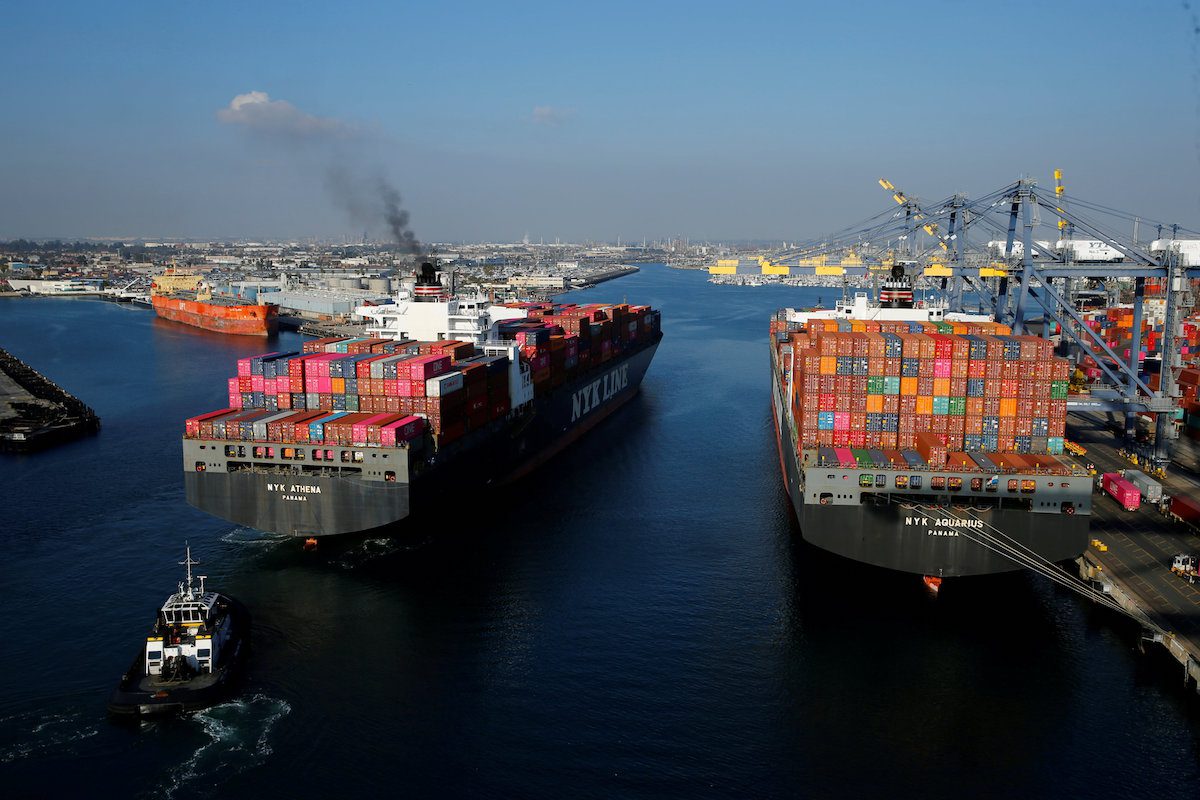FILE PHOTO: A container ship arrives at Yusen Terminals (YTI) on Terminal Island at the Port of Los Angeles in Los Angeles, California, U.S., January 30, 2019. REUTERS/Mike Blake/File Photo
By Mike Wackett (The Loadstar) – US west coast ports suffered most from a “tariff hangover” effect in 2019’s first three months, said Drewry Maritime Research in a new research note today.
Transpacific imports were down some 19% on the previous quarter and by 3% year on year.
However, PIERS data for the first quarter did record growth for Asia to US east and Gulf coast ports at 4% on last year, said the consultant.
“The west coast market was always likely to suffer the most from a tariff hangover, as shippers had prioritised that gateway as the quickest means to beat the deadline [for import duty hikes on Chinese imports],” said Drewry.
“Now that the sugar rush, caused by the threatened tariffs on Chinese goods, has passed, the market is readjusting to much slower volumes and prices,” it added.
According to Drewry , after a very healthy supply-demand situation on the Asia-US west coast tradelane in January, with near-100% load factors on headhaul vessels, February saw this balance tip dramatically against carriers, slumping to an average vessel utilisation of 80%, the lowest in two years.
Consequently, spot rates on the route came under pressure and have now fallen by around 20% since the start of the year, to $1,606 per 40ft – as recorded on Friday’s Shanghai Containerized Freight Index (SCFI).
The timing of the spot rate slump “could not have occurred at a more inopportune moment”, noted Drewry, given that carriers are in the process of trying to secure rate increases on annual contract renewals that commence on 1 May.
“Earlier in the year, it seemed the carriers might be able to secure some modest increase in revenue from their BCO contracts, but those hopes now seem dashed,” suggested Drewry.
“The only discussion point that remains is to what extent the shipping lines can secure some agreement to a floating BAF arrangement within those contracts, so that when, towards the end of 2019, the carriers start having to pay a premium for low-sulphur fuel oil, they can rely on some mechanism to kick in to automatically recover some of those additional costs,” it added.
At the TPM Conference in Long Beach last month, shippers told The Loadstar carriers were putting much more emphasis on getting agreement for the acceptance of their fuel price increase formulae than on securing higher contract rates.
Hapag-Lloyd’s chief executive, Rolf Habben Jansen, told The Loadstar the carrier had succeeded in obtaining 100% acceptance of its new MFR (marine fuel recovery) mechanism, or for “customer formulae very close to ours” from its transpacific customers.
Drewry said there was also a possible scenario wherein BCO importers might be prepared to agree small increases in their contract base rates in order to guarantee space.
BCOs see it as an insurance policy against a repeat of the front-loading situation in the final quarter of last year that obliged shippers to pay a premium to carriers for exceeding their weekly allocations.
Meanwhile, notwithstanding the uninspiring rate situation facing carriers on the Asia-US west coast trade, Lars Jensen, chief executive and partner at SeaIntelligence Consulting, said carriers faced headwinds on other routes, commenting: “There is clear cause for concern – precisely because the weakness is so widespread.”
The Loadstar is fast becoming known at the highest levels of logistics and supply chain management as one of the best sources of influential analysis and commentary.
Check them out at TheLoadstar.co.uk, or find them on Facebook and Twitter.
Unlock Exclusive Insights Today!
Join the gCaptain Club for curated content, insider opinions, and vibrant community discussions.

 Join The Club
Join The Club







![A screengrab of a map showing an earthquake Mindanao, Philippines on Dec 2, 2023. (Image: US Geological Survey [USGS])](https://gcaptain.com/wp-content/uploads/2023/12/Screenshot-2023-12-02-at-10.45.17-AM-copy.png.webp)





